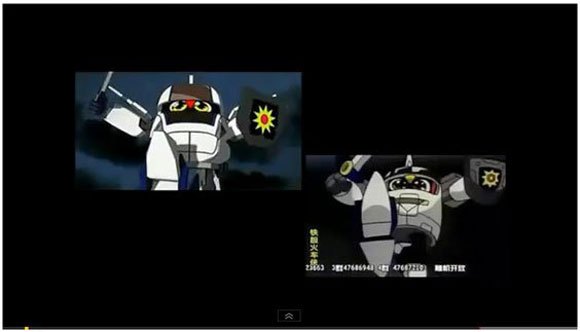
Over the past few years, China’s animation industry has greatly expanded and produced many all-new domestic works. However, these “original” animations have been placed under a lot of suspicion from sources both domestic and foreign for their blatant mimicry of Japanese and American animation sources. Many accuse China’s fledgling animation industry of relying on rip-offs to sell.
In response to these claims, an opinion piece titled “How Chinese Animation has Progressed Through ‘Imitation,’” was posted on one of China’s major cartoon and comics information sites. The column insists that China’s domestic animations should not be thought of as rip-offs but as inspired copies made for the sake of further developing their infant cartoon industry.
Since its original publication, this Chinese opinion piece has caught the attention of more than just fans and bloggers. In August, it was picked up by Japan’s Agency for Cultural Affairs, and it was even republished on the Chinese government’s official cultural division website. Here is a rough translation of the column’s contents:
“Lately, a lot of Chinese animation has come under suspicion. “This is stolen, a perfect rip-off, copy, no originality.” China’s domestically produced cartoons are currently under attack. Certainly, China’s inexperienced animators are no match for those in Japan and America. However, it is through imitation that we are progressing, and the increasing number of Chinese citizens watching domestic cartoons is proof of that.
“At present, many of China’s television shows and movies are under suspicion of being rip-offs. For example, the movie, 魁抜 (pronounced Kuiba), which was released in 2011 gave many of the nation’s young men a sense of déjà vu. Net users clamored that the series’ tone and characters had a distinctly Japanese feel, just like Dragon Ball.
“It happened again with a scene from 高鉄侠 (The Railway Boy) this July. Net users immediately speculated, “That’s been completely stolen from Japan’s ‘Choutokkyuu Hikarian JAPAN HIKARIAN RAILWAY.’”
“China’s viewers have become quite familiar with Japanese, Korean, and Western animation styles, such that when they see the slightest resemblance, they scream “rip-off.” Why not replace that word with one like “imitation.”
“Our Chinese domestic animation is late to develop, but we need to press forward. At the same time, we must plan for the future of Chinese animation. Chinese cartoon producers are continuing to develop. They are still thinking of how best to approach their works with more originality.”
According to the article above, the nuances of our language are influencing the way that we think about China’s budding animation industry. Rather than accuse the country’s animators of producing “rip-offs,” the author hopes to promote the classification of these pieces as “imitations,” a term with far fewer negative connotations. He sees China’s mimicry of other animation styles as a form of learning rather than a form of stealing. And who would blame them for wanting to learn from the best, taking elements from animated works which are already famous and have demonstrated a high level of success?
However, this does not change the fact that Chinese companies are pulling a profit from material which is not under their copyright. In the case of The Railway Boy and its original Japanese counterpart, Choutokkyuu Hikarian, it was not just the character designs which show some similarities, the entire six-minute story progression matches exactly!
I, like many others, anticipate the day that China is able to impress the world with some original animated works, but in the meantime, we should probably ask ourselves how much appropriation is acceptable and for how long it should be allowed to continue. Take a look at the videos below and decide for yourselves how to classify these animated works. Is this really a case of mimicry or thievery?
▼ On the right, you’ll see the Japanese series, Choutokkyuu Hikarian. On the left is China’s 2013 animation, The Railway Boy.
▼ Here is the first trailer for the Chinese animated movie, Kuiba, under some suspicion for its similarities to Dragon Ball.
▼ And here is the trailer for Kuiba’s sequel.
References: Sina Video and VASOON on YouTube
[ Read in Japanese ]

 16 facts about China that will blow your mind
16 facts about China that will blow your mind 9 ‘Spiritually Japanese’ Cosplayers, Cartoonists Arrested in China For ‘Anti-China Extremism’
9 ‘Spiritually Japanese’ Cosplayers, Cartoonists Arrested in China For ‘Anti-China Extremism’ Chinese Communist Party tries to spit the straight skinny in its rap about China, Taiwan 【Video】
Chinese Communist Party tries to spit the straight skinny in its rap about China, Taiwan 【Video】 Some of the passengers on China’s rural railways are literally pigs
Some of the passengers on China’s rural railways are literally pigs Egypt complains over China’s fake Sphinx【TomoNews Video】
Egypt complains over China’s fake Sphinx【TomoNews Video】 Japanese ramen restaurants under pressure from new yen banknotes
Japanese ramen restaurants under pressure from new yen banknotes McDonald’s Japan releases a pancake pie for new retro kissaten coffeeshop series
McDonald’s Japan releases a pancake pie for new retro kissaten coffeeshop series McDonald’s new Happy Meals offer up cute and practical Sanrio lifestyle goods
McDonald’s new Happy Meals offer up cute and practical Sanrio lifestyle goods French Fries Bread in Tokyo’s Shibuya becomes a hit on social media
French Fries Bread in Tokyo’s Shibuya becomes a hit on social media New private rooms on Tokaido Shinkansen change the way we travel from Tokyo to Kyoto
New private rooms on Tokaido Shinkansen change the way we travel from Tokyo to Kyoto Beautiful Ghibli sealing wax kits let you create accessories and elegant letter decorations【Pics】
Beautiful Ghibli sealing wax kits let you create accessories and elegant letter decorations【Pics】 Secret Kitchen bento serves Japanese flowers, birds, wind and moon in a box, but is it worth it?
Secret Kitchen bento serves Japanese flowers, birds, wind and moon in a box, but is it worth it? Beautiful Red and Blue Star luxury trains set to be Japan’s new Hokkaido travel stars
Beautiful Red and Blue Star luxury trains set to be Japan’s new Hokkaido travel stars A trip to hell on Japan’s ‘vomit ship’: Is it as bad as everyone says it is?
A trip to hell on Japan’s ‘vomit ship’: Is it as bad as everyone says it is? We tried Korea’s way-too-big King Tonkatsu Burger at Lotteria 【Taste Test】
We tried Korea’s way-too-big King Tonkatsu Burger at Lotteria 【Taste Test】 All-you-can-drink Starbucks and amazing views part of Tokyo’s new 170 meter-high sky lounge
All-you-can-drink Starbucks and amazing views part of Tokyo’s new 170 meter-high sky lounge More foreign tourists than ever before in history visited Japan last month
More foreign tourists than ever before in history visited Japan last month Starbucks reopens at Shibuya Scramble Crossing with new look and design concept
Starbucks reopens at Shibuya Scramble Crossing with new look and design concept Studio Ghibli releases new action figures featuring Nausicaä of the Valley of the Wind characters
Studio Ghibli releases new action figures featuring Nausicaä of the Valley of the Wind characters Studio Ghibli glasses cases let anime characters keep an eye on your spectacles
Studio Ghibli glasses cases let anime characters keep an eye on your spectacles Is the new Shinkansen Train Desk ticket worth it?
Is the new Shinkansen Train Desk ticket worth it? Studio Ghibli releases Kiki’s Delivery Service chocolate cake pouches in Japan
Studio Ghibli releases Kiki’s Delivery Service chocolate cake pouches in Japan New definition of “Japanese whiskey” goes into effect to prevent fakes from fooling overseas buyers
New definition of “Japanese whiskey” goes into effect to prevent fakes from fooling overseas buyers Our Japanese reporter visits Costco in the U.S., finds super American and very Japanese things
Our Japanese reporter visits Costco in the U.S., finds super American and very Japanese things Studio Ghibli unveils Mother’s Day gift set that captures the love in My Neighbour Totoro
Studio Ghibli unveils Mother’s Day gift set that captures the love in My Neighbour Totoro Domino’s Japan now sells…pizza ears?
Domino’s Japan now sells…pizza ears? New Japanese KitKat flavour stars Sanrio characters, including Hello Kitty
New Japanese KitKat flavour stars Sanrio characters, including Hello Kitty New Pokémon cakes let you eat your way through Pikachu and all the Eevee evolutions
New Pokémon cakes let you eat your way through Pikachu and all the Eevee evolutions Sales of Japan’s most convenient train ticket/shopping payment cards suspended indefinitely
Sales of Japan’s most convenient train ticket/shopping payment cards suspended indefinitely Sold-out Studio Ghibli desktop humidifiers are back so Totoro can help you through the dry season
Sold-out Studio Ghibli desktop humidifiers are back so Totoro can help you through the dry season Japanese government to make first change to romanization spelling rules since the 1950s
Japanese government to make first change to romanization spelling rules since the 1950s Ghibli founders Toshio Suzuki and Hayao Miyazaki contribute to Japanese whisky Totoro label design
Ghibli founders Toshio Suzuki and Hayao Miyazaki contribute to Japanese whisky Totoro label design Doraemon found buried at sea as scene from 1993 anime becomes real life【Photos】
Doraemon found buried at sea as scene from 1993 anime becomes real life【Photos】 Tokyo’s most famous Starbucks is closed
Tokyo’s most famous Starbucks is closed One Piece characters’ nationalities revealed, but fans have mixed opinions
One Piece characters’ nationalities revealed, but fans have mixed opinions We asked a Uniqlo employee what four things we should buy and their suggestions didn’t disappoint
We asked a Uniqlo employee what four things we should buy and their suggestions didn’t disappoint Princesses, fruits, and blacksmiths: Study reveals the 30 most unusual family names in Japan
Princesses, fruits, and blacksmiths: Study reveals the 30 most unusual family names in Japan China is trying to build an empire of electric cars—but the strategy has one huge flaw that will benefit Tesla
China is trying to build an empire of electric cars—but the strategy has one huge flaw that will benefit Tesla Upcoming Australian-made card game battle anime is a confusing mix of genres
Upcoming Australian-made card game battle anime is a confusing mix of genres Chinese Disney fans worry that an upcoming Pixar short film will be banned from theaters
Chinese Disney fans worry that an upcoming Pixar short film will be banned from theaters Amazing new AI program transforms photos into gorgeous amine artwork【Video】
Amazing new AI program transforms photos into gorgeous amine artwork【Video】 Video accuses Your Name of copying two of its animation sequences from other anime【Video】
Video accuses Your Name of copying two of its animation sequences from other anime【Video】 China’s Special Forces in Hong Kong go through a ridiculous training regimen
China’s Special Forces in Hong Kong go through a ridiculous training regimen The dirty reason China can’t always tell North Korea what to do
The dirty reason China can’t always tell North Korea what to do Beautiful Chinese snuff bottles reverse-painted on the inside impress Japanese netizens【Video】
Beautiful Chinese snuff bottles reverse-painted on the inside impress Japanese netizens【Video】 China to remove six million cars from its roads in an effort to make city air breathable again
China to remove six million cars from its roads in an effort to make city air breathable again China’s ‘Rent-a-Foreigner’ industry is booming
China’s ‘Rent-a-Foreigner’ industry is booming Vietnamese police detain 16 pigeons on suspicion of being Chinese spies, discover true identities
Vietnamese police detain 16 pigeons on suspicion of being Chinese spies, discover true identities Chinese commenter equates recent anime with fast food–What do you think?
Chinese commenter equates recent anime with fast food–What do you think? 2025 Osaka World Expo aims to be first in the world to allow dogs, possibly cats too
2025 Osaka World Expo aims to be first in the world to allow dogs, possibly cats too Massive kung fu vs. taekwondo brawl breaks out at shopping mall between beefing schools【Video】
Massive kung fu vs. taekwondo brawl breaks out at shopping mall between beefing schools【Video】 Chinese businessman sets his sights on driving Disney Resort out of Shanghai
Chinese businessman sets his sights on driving Disney Resort out of Shanghai
Leave a Reply